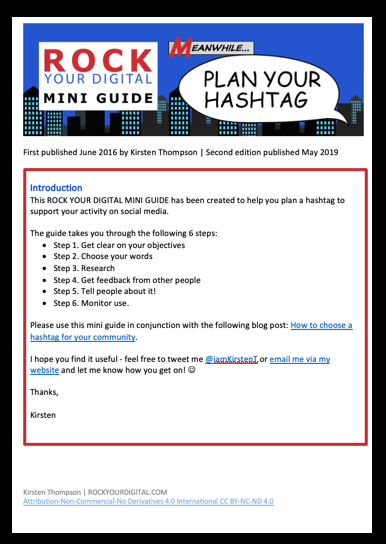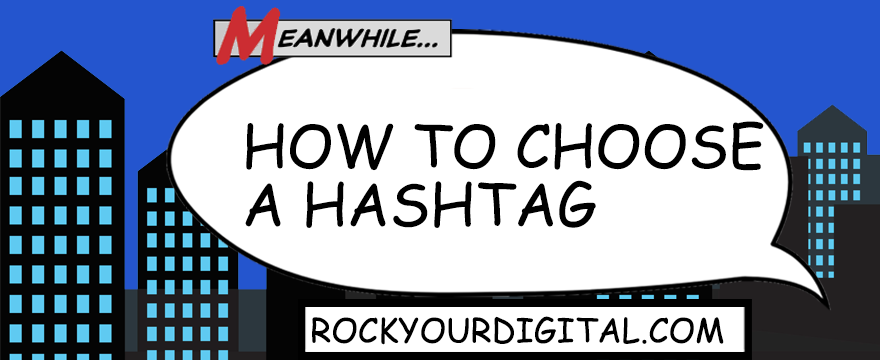[Post updated 28/05/19]
Are you thinking of launching a hashtag to build your community? If so, there are some important things to consider first. This post takes you through six steps to help you choose a hashtag and plan your strategy. There’s a free printable you can download too, if you want some extra tips and like structured hand-outs. 🙂 I’ve updated it for 2019 and made it available under a Creative Commons license.
If you’re not clear about hashtags and the advantages of using them, read this post first; Hashtags: what are they and why use them?
You cannot own a hashtag
We can all choose to create a hashtag, associate it with our personal brand, network, course, event or business etc., but we cannot legally claim ownership of that hashtag. Like most things on social media, it’s one of those things that we cannot control. After all, a hashtag is just a metadata tag or keyword.
It can be frustrating and we cannot stop other people from exploiting hashtags e.g. your hashtag might trend on Twitter due to live engagement with it at an event, or during a Twitter chat. Spammers will see your hashtag is trending and therefore being used and seen by lots of people. They will then exploit that by using your hashtag for a completely different purpose e.g. to promote their own products, services or try and encourage people to click on a link to a phishing scam. That aside, hashtags can still be super-valuable for you, especially if you want to build a community online.
Choose a hashtag
1. Get clear on your objectives
If you are creating a hashtag it should have a specific purpose, so start by nailing your objectives and that will help you identify an appropriate hashtag.
2. Choose your words
If you’re anything like me, I love to scribble on paper to brainstorm my ideas. With your objectives in mind, write down the keywords that come to mind. Do those words also reflect your values, if relevant?
3. Research
This step is essential. If you are looking to launch a hashtag that is unique, you need to search and see if anyone else is already using it. It’s usually better to avoid a single word that cannot only be associated with you or your brand, because other people will use the hashtag for entirely different purposes.
Also, there’s another reason why it’s REALLY important to do your homework…your potential hashtag might return unexpected results e.g. I used to co-organise an annual event at the University of Leeds called Hands on the Future (it was a learning technology event for staff and PhD students). Internally via email, we would refer to the event as HOTF. There was no way I could use that as the official event hashtag though because back in 2010, when we first launched the event, a quick search on Twitter for #HOTF would return results for #hotfemales!
Can you imagine, if we’d had those tweets appearing in our feed and projected onto a big screen?! Thankfully, I did my homework (phew!) and instead added the year onto the end #hotf10, which resolved the problem.
A few years later though, #hotf14 was adopted by another community, across the Pond. No control. We’d already promoted the event and the hashtag (via a Twitter account I have since closed and on paper), and as there were only a few tweets from the other community, we stuck with it. It was a small one-day event after all and the content posted by the other community was a couple of months before the event took place, so did not have any real negative impact.
It’s also useful to research across platforms, even if you plan to use a hashtag on a single platform, you and your community might use it elsewhere too.
4. Get feedback from other people
Make sure there’s no misunderstanding and alternative meaning before you announce your hashtag to the world. Sometimes we just do not see what someone else sees, until it’s pointed out.
Hashtag fails
Here’s a few examples of hashtags with alternative meanings that went viral (for all the wrong reasons!):
- #Therapist was interpreted as #TheRapist
- #NowThatcherIsDead was interpreted as #NowThatCherIsDead
- #SusanAlbumParty quickly became #SusAnalBumParty

5. Tell people about it
Once you’ve done your homework and decided on your hashtag, you need to promote it, not only on the channel where you plan to use it, but also across all of your channels e.g. your website, other social media profiles (include your hashtag in your profiles where relevant), groups and pages, as well as via email. Don’t forget more traditional channels too, like flyers, posters and business cards, where relevant.
6. Monitor use
Once your hashtag is out there in the world, use it to listen to your community, acknowledge feedback and answer questions. Also, consider your options if you find someone else using it for an alternative purpose in a persistent manner. You might want to approach them and have a polite conversation about how mixed-use of a hashtag won’t help either of you and take it from there.
Free workbook to help you choose a hashtag
I’ve created a printable to walk you through these steps with some extra detail to help with planning. It’s available in Word and PDF format via Word Online and you can access it via the RYD Resources (page), which you can sign up to access, below.


Leave a Reply